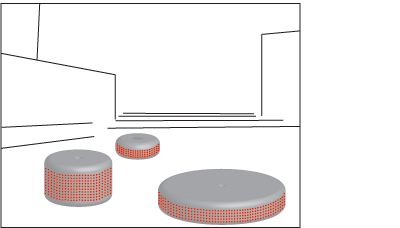The installation consists of several circular objects,
which serve as seats, encapsulate the sound devices and display visual patterns. The amount of seats as well as their sizes depend on the dimension of the place. The placement of the seat objects should be related to the properties of the site, viewing borders, open paths and the set up of more intimate small groups of seats. One person sitting on a circular object is surrounded by its personal sounds and can observe or hear other individual sounds and patterns near by.

Each seat has a band of red LED-based light sources of the same type, which can be readily operated in parallel. We use the LEDs (Light-emitting diode) as information indicators, more precisely to generate various animated minimalist patterns according to the sound output. LEDs have several advantages: they are safe and easy to maintain and have an average working lifetime of ten years. Compared to other light sources like fluorescent tubes LEDs are robust and moderately efficient, they generate up to 32 lumens per watt. Because of its outdoor use and the direct sunlight exposure, we will have to test the needed amount of nits. If the required brightness could not be achieved, the patterns will be only visible in the dark.

Each personal sound has a visual equivalent. The LEDs generate animated patterns, visual representations of the audio output. Even if other people can't hear the personal sounds, they remark the visual representation. By combing the audio-visual output we offer several different indicators to memory. The idea is that people recognize other people patterns or sounds.
Patterns will be generated following graphical notation systems in music. This will include research of Braille music, John Cage's Notations, and other practitioners.